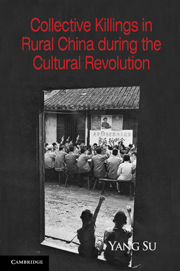Book contents
- Frontmatter
- Contents
- List of Figures
- List of Tables
- Preface and Acknowledgments
- 1 Kill Thy Neighbor
- 2 On the Record
- 3 Community and Culture
- 4 Class Enemies
- 5 Mao's Ordinary Men
- 6 Demobilizing Law
- 7 Framing War
- 8 Patterns of Killing
- 9 Understanding Atrocities in Plain Sight
- Appendix: Methodological Issues and Statistical Analyses
- References
- Index
7 - Framing War
Published online by Cambridge University Press: 05 June 2012
- Frontmatter
- Contents
- List of Figures
- List of Tables
- Preface and Acknowledgments
- 1 Kill Thy Neighbor
- 2 On the Record
- 3 Community and Culture
- 4 Class Enemies
- 5 Mao's Ordinary Men
- 6 Demobilizing Law
- 7 Framing War
- 8 Patterns of Killing
- 9 Understanding Atrocities in Plain Sight
- Appendix: Methodological Issues and Statistical Analyses
- References
- Index
Summary
At 1 A.M. on July 25, 1968, Zhou Enlai, Kang Sheng, and six other prominent central leaders held a meeting with representatives of Guangxi Province's mass-organization leaders in the People's Meeting Hall in Beijing. Speeches by the leaders heavily favored the United Headquarters (UHQ), one of two mass alliances in Guangxi, at the expense of April 22 (or Four Twenty Two [FTT]), the rival faction. Zhou and Kang also announced the existence of a vast counter-revolutionary conspiracy organization, which they called the Anti-Communist Party Patriotic Army (ACPPA). They did not cite any concrete evidence for, indeed, there was none to cite, but this supposedly anti-communist force was portrayed as widespread, extending far beyond Guangxi Province. The meeting effectively endorsed the war rhetoric used by the provincial government, now dominated by the UHQ, which had first claimed that its political opponents in the FTT were members of this anti-communist army. Collective killings had begun in Guangxi counties and soon spread to Guangdong Province.
Since 1949, the new regime had maintained a politically constructed class divide and governed using the doctrine of class struggle (see Chapter 4). The doctrine was not merely a theoretical principle; in a self-fulfilling-prophecy fashion, it also turned into “reality” by the constant campaigns against class enemies. “Sabotage acts” against the state were identified – although they were either exaggerated or fabricated – and discriminations, persecutions, and abuses were publicly featured to reconfirm the “truth” of class struggle.
- Type
- Chapter
- Information
- Publisher: Cambridge University PressPrint publication year: 2011

